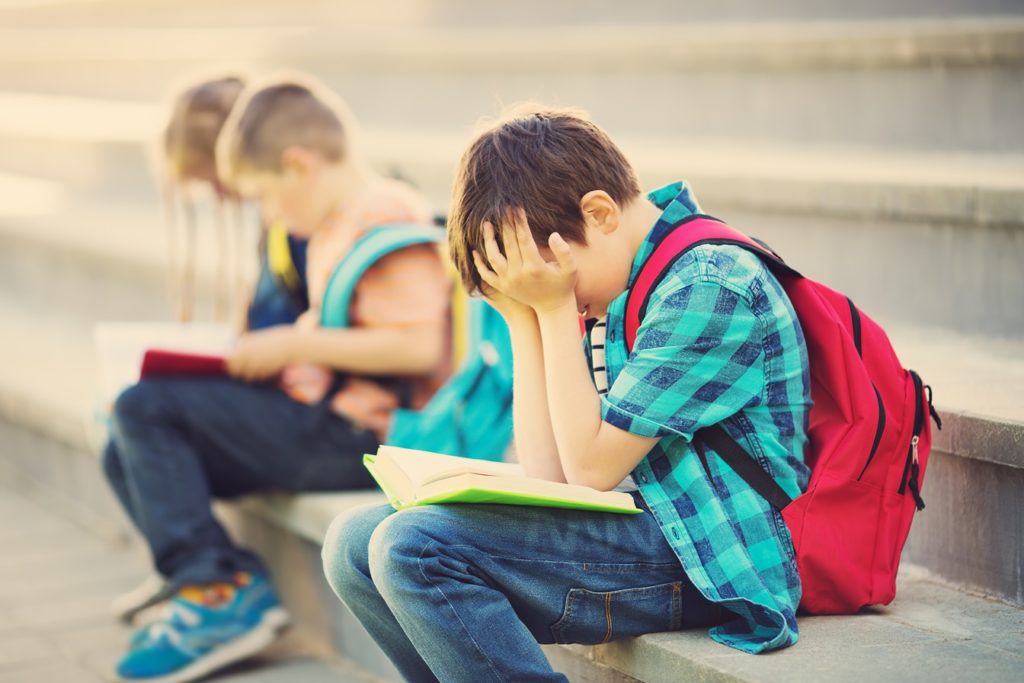Back to school time can literally mean headaches for kids as they adjust from a relaxing summer vacation schedule to a more stringent daily routine. Everybody knows that going back to school can be stressful – different teachers, new friends, and a whole new set of responsibilities can overwhelm even the most confident of kids or teenagers. Parents should be aware that their children are at higher risk for developing headaches and migraines at the beginning of a new school year. As high as 35% of kids can suffer from some type of reoccurring headache, and up to a quarter of those headaches can be migraines. Emotional issues, stress, and sleep issues can cause migraines in these children. As the number of attacks increase, depression and sleep disorders can escalate.
Head pain can range from minor nuisances to extremely uncomfortable, and when they become chronic (constantly recurring), they can take a serious toll on a child’s ability to go about daily life. There are several types of headaches: cluster headaches, tension headaches, sinus headaches, and many more. However, one of the most common (and intense) types of head pain is the neurological disorder migraine.

Migraine in Children is Often Overlooked
While adults typically have one-sided head pain with migraine attacks, children often experience pain on both sjides of the head and the headaches are commonly accompanied by sensitivity to light and sound. Pediatric migraines are usually much shorter in duration than adult migraines making them hard to treat. Sometimes a child will develop a severe headache, stomach pain or nausea, and then vomit and the episode is over. For this reason, parents and doctors alike may misdiagnose migraine as something else.
Migraines don’t just affect adults; some children start suffering from them as early as the age of two, and it is estimated that around 10% of all school-aged kids and teenagers get migraines periodically. Children’s migraines may be more bilateral such as pain across the forehead as opposed to unilateral, one side of the head. The pain may be of shorter duration than an adult’s migraine and less frequent.
Children may also experience abdominal migraines, severe stomach pain without a headache which may or may not be accompanied by vomiting. If you child experiences cyclic vomiting or stomach pain, ask your pediatrician about abdominal migraine. Unfortunately, doctors and researchers are not completely sure of what causes migraine. Migraines are thought to be hereditary. A child with one parent who suffers with migraines has a 50% risk of developing them. If both parents suffer with migraines, the risk increases to 75%.
What Are Migraine Triggers?
While on the surface migraines seem to come out of nowhere, most people can identify at least some of the factors that set off an attack. These factors are called triggers, and they vary from person to person. For some, triggers can be as specific as particular sounds or smells, while for others, their triggers can be extremely common daily events like stress or hormonal changes, and therefore are much harder to avoid.
Learning to identify triggers can significantly reduce both the amount and the severity of migraines as the new school year starts. According to the National Headache Foundation, the amount of migraine and headache-related visits to the emergency room by children between the ages of 5 and 18 increases every year around fall.
As you may have already guessed, stress is one of the main culprits of back to school migraines; children as young as five can feel anxious and overwhelmed about schedule changes, new extracurricular activities, and everything else that comes with the beginning of a new academic year. But stress is not the only factor that can set off migraines on school-aged children and young adults. Other common triggers include:
Sleep deprivation
The National Sleep Foundation recommends that children between the ages of four and 13 get 10 to 12 hours of sleep every night. A good night’s sleep is not only essential for growth and development; it also has been shown that sleep deprivation is one of the most common migraine triggers for both children and adults.
However, more than 90% of high-schoolers and nearly 80% of middle-schoolers start school before 8:30 am. It is also common that teens don’t fall asleep before 11:00 pm, making it harder to get the recommended amount of sleep each night. As if that wasn’t enough, during the first weeks of school, thanks to all the stress and excitement of the new academic year, kids and teens find it even harder to get enough sleep.
Skipping meals
Skipping or waiting too long between meals is also a big migraine trigger for school-aged children and young adults. During the first few weeks of school, as kids settle into their new schedules, it can be easy to skip breakfast or grab a quick snack for lunch, but this could mean bad news for migraine sufferers.
Skipping meals or waiting too long to ear, can cause blood sugar levels to drop too low. This is called hypoglycemia and it usually causes headaches even for people who don’t suffer from migraines. Migraine attacks and headaches caused by low blood sugar levels are usually more painful and can last longer than other attacks. They also tend to be accompanied by blurred vision, nausea, excessive yawning, sweating, and mood swings.
Screen time
It is important to monitor your children’s screen time to avoid migraines and headaches. Most of us have suffered the consequences of spending too much time on the computer or staring at our phones; our eyes hurt, our neck becomes stiff, and almost inevitably a headache creeps in. Migraine attacks triggered by the computer or phone screen are becoming increasingly common now that we spend a good portion of our days on our electronic devices.
Prolonged screen time has been shown to trigger migraines for several reasons: first, fixating your eyes on a monitor for a long time requires effort from both your brain and your ocular muscles, both of which have to work quite hard to keep focused on the screen for an extended period of time.
Also, extremely bright screens can trigger migraines in people who are photosensitive (sensitive to bright lights). Aside from these factors, hunching over the computer, tablet or phone can lead to neck and back pain which can worsen migraines.
Dehydration
Did you know that healthcare professionals estimate that 75% of Americans are chronically dehydrated? There is a lot of controversy regarding how much water a person should drink; some sources recommend 8 glasses, others have said that the appropriate amount is between 11 and 15 cups, and others assure that drinking 2 to 3 cups of water every hour should be enough to keep you hydrated.
Remind your kids to stay well hydrated. Ultimately, the amount of water people need is based on a variety of factors like their weight, activity level, whether it is hot or cold outside, etc. The best way to avoid dehydration is to keep a water bottle with you at all times and don’t wait until you are thirsty to drink – according to healthcare professionals, once thirst hits you are already dehydrated!

Other common migraine triggers for school-aged children and teens include:
- Caffeine
- Loud noises
- Strong odors
- Lunch meats
- Chocolate
- Salty foods
- Alcohol and smoke
- Stress
- Some types of cheese
- Food additives and chemicals (like MSG)
- Teeth grinding
- Weather changes
Managing Migraines at School
As you may have realized, some of the most common school-related migraine triggers can be hard to avoid. Since there is nothing you can do to control triggers like the temperature outside, puberty and hormonal changes, bright lights in the classroom, and loud noises, managing migraines can become a frustrating task.
The good news is that other triggers like lack of sleep, stress, skipping meals, and dehydration can be prevented by making healthier choices. Here are five tips to keep migraines at bay during the school year.
1. Improve Sleep Hygiene
Even though according to the Centers for Disease Control and Prevention (CDC), kids and teenagers could benefit from starting school later in the day both health and academic-wise, most children still have to wake up before 7:00 am to get to school on time. This means that getting enough sleep can be an extremely difficult – if not impossible task for some kids.
But if you suffer from migraines, maintaining good sleeping habits should be just as important as eating healthy or exercising. We recommend getting ready to sleep and practicing good sleep hygiene habits hours before you even go to bed to get the best quality sleep possible.
By limiting daytime naps as much as possible, making sure you don’t consume caffeine or foods that can disrupt sleep (particularly fatty, sugary or rich foods) too close to bedtime, and not bringing your cellphone or tablet to bed, you will be able fall asleep earlier and keep insomnia from triggering a migraine. For the first few weeks of school, try going to bed earlier than usual as that will help you get more sleep in and reduce the stress and anxiety that comes with the new school year.
2. Keep a Trigger Tracker
One of the worst things about migraines is not knowing when they are going to happen. Getting a headache before a midterm, right in the middle of class or during an extracurricular activity can be extremely frustrating. That’s why learning to recognize the factors that set them off is extremely important, and the best way of doing so is with a trigger tracker.
Keeping a trigger tracker is easy; you can use a notebook, a diary or your phone to list anything that was consumed or that happened right before a migraine started. Have your child note, for example, if they were about to take a test when the headache began, or were in the middle of PE; these are all things worth noting. Other important things to include on a trigger tracker or migraine diary are any symptoms that your child felt (auras) leading up to the attack, where the pain was located, the weather that day, etc.
Over time, you will be able to connect the dots and identify some of the factors that may cause or worsen your child’s migraines. Learning to recognize these factors can help prevent future migraines or at least be prepared when it happens. (Downloadable Migraine Diary & Trigger Tracker)
3. Consider Targeted Nutritional Supplement
Targeted nutritional supplements are a safe and healthy option for kids. Different plant extracts, vitamins, and minerals have been clinically proven to be beneficial for adults and children over the age of two with migraines. The following three have scientific evidence supporting their effectiveness:
Magnesium – Several studies have shown that migraines may be partly caused by low magnesium levels in the brain, which is why taking a daily magnesium supplement is so important for kids with migraine. Magnesium has numerous effects that support cerebrovascular tone and function (blood vessels in the brain). 180 mg per day for children and 360 mg per day for adults and teens is recommended.
Feverfew – The herb feverfew is a plant that belongs to the daisy family and has also been shown to be extremely beneficial for adults and children suffering migraines. Feverfew has been known to help maintain normal platelet aggregation (avoid excessive clumping together of blood platelets) and reduce or eliminate vasospasms in the brain’s blood vessels. 50 mg per day for children and 100 mg per day for adults is recommended.
Vitamin B-2 (Riboflavin) – Many migraine sufferers are known to have mitochondrial energy deficiencies before a migraine attack. The mitochondria are the powerhouses of cells. Riboflavin at the correct dose helps maintain healthy mitochondrial energy reserves, also crucial for migraine sufferers. 200 mg per day for children age 2-12 and 400 mg per day for teens and adults is recommended.
Remember, when it comes to taking dietary supplements, consistency is key for migraine sufferers. There is a build-up period of up to 3 months where supplements must be taken every day to experience maximum benefits.
MigreLief – Comprehensive Supplements Created Just for Migraine Sufferers
If your child suffers migraines chronically, consider starting a MigreLief daily (taken 1 caplet in the morning and one at night, everyday)
- MigreLief Original Formula (teen-adult) or
- Children’s MigreLief (age 2-12)
MigreLief is a dietary supplement that makes a difference through nutritional support by maintaining normal cerebrovascular tone and function, maintaining healthy mitochondrial energy reserves (powerhouses of brain cells) and promoting a healthy inflammatory response. These processes are key to a migraine sufferer’s health and well-being.
Although many people have experienced positive benefits with MigreLief or Children’s MigreLief in under one month, the triple therapy ingredients (magnesium, riboflavin and Puracol™ feverfew) can take up to 3 months for maximum benefits. You should notice it growing in effectiveness over that time period. We suggest keeping the fast-acting formula MigreLief-NOW on hand during the build-up period and taking as-needed for on-the-spot neurological comfort.
June or July is a good time to start the MigreLief nutritional regimen before school starts however it is never too late to start down the right path and give your child a better start in life.
MigreLief dietary supplements are recommended by many pediatric neurologists and headache specialists. It is available in a daily formula and an as-needed formula (MigreLief-NOW) for children age 2-adult.
4. Make a Plan
Once you’ve been able to identify migraine triggers using a tracker or a diary, plan ahead to avoid a ‘surprise’ attack when possible. During the first few weeks of school, help your child to remove any unnecessary stressors from his or her day to day activities; for example, have your child pack his or her backpack the night before so he or she is not running around in the morning looking for supplies – stressing out early in the morning, or as we mentioned earlier, skipping breakfast, are big migraine triggers.
Also, your child should keep emergency snacks in a bag or backpack in case of hunger during the day but remember that fatty or sugary foods sometimes trigger headaches. Some quick snacks that are considered “migraine safe” foods include:
- Plain pretzels
- Saltines
- Bread (white, wheat, rye, bagels, etc.)
- Cereal (except sugary cereals or cereals with nuts or dried fruits)
- Carrot sticks or other vegetables
5. Reach Out
Suffering from migraines at school can make children feel isolated and different from peers. Sometimes they may choose to avoid hanging out with friends or skip social events because they are concerned about getting a migraine. Many people who suffer from migraines feel lonely and misunderstood because of their chronic pain. To fight those feelings of loneliness and frustration, it is important to encourage your child talk about what they are feeling and to reach out to friends and family members who want to be supportive.
Parents should also talk to the teacher or guidance counselor – more often than not schools offer resources like testing accommodations, screen reading technologies to help with eye strain, photo-sensitivity, and more.
Remember that there are things you can do to keep migraines from controlling your child’s life, like having your child stick to a good migraine prevention regimen including sticking to a healthy sleep schedule.
To the Best of Health,
The MigreLief Team at Akeso Health Sciences

For more health tips, help for migraine headaches, coupons and more, visit MigreLief.com and subscribe to our newsletter!


